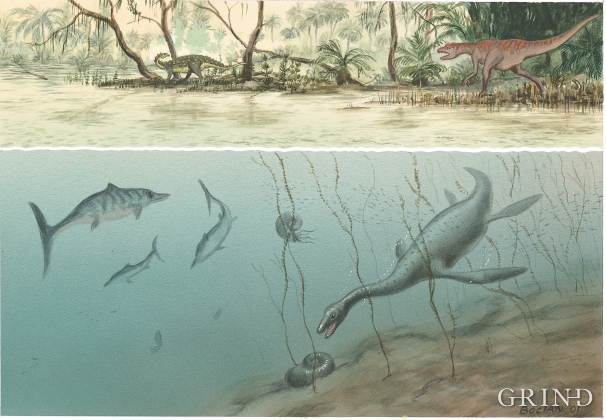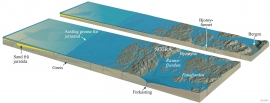Published: 05.08.2015 | Author: Haakon Fossen
Fantasy drawing of the animal life that reigned when the Bjorøy layer was deposited during the younger part of the Jurassic Period. On land: Dracopelta (left), a plant-eater, and the meat-eating dinosaur Allosaurus (right). Under water: Marine reptile of the animal group Icthyoasurus (farthest left) and Pleisiosaurus (right). Ammonites, a type of squid that lives in a spiral shell, lies on the bottom, while another ammonite swims through the water. (Bogdan Bocianowski)
There are coal bits hidden in the sand under Vatlestraumen. These remains from a geological layer from the Jurassic Period were discovered when the undersea Bjorøy Tunnel was built in 1994. Oil- and gas reservoirs in the Troll Field in the sea west of Hordaland are from the same time. It is, nonetheless, quite surprising to find bedrock from dinosaur time inside of the outer islands of western Norway. On the Scandinavian mainland north of Denmark, there are only a very few places where one f inds rock from this time in earth history.
The tunnel work turned out to be much more difficult than the builders had planned on. In the autumn of 1994, the situation became dramatic. Saltwater gushed out from a borehole, at a rate of about two hundred litres per minute. Along with the water, loose sand and coal fragments entered the tunnel. It appeared that the tunnel workers had come into contact with a roughly 10 metre-wide zone containing loose remains of coal, sand, sandstone and conglomerate.
Though the tunnel-builders despaired, the researchers were very happy for this discovery. The up to 20 cm- large coal fragments are the remains of a coal layer that had been broken up by fault-movements after being deposited. Probably, there was a tree covered coastal plain in this area during the Jurassic Period. Some of the coal fragments are identified as parts of tree trunks or branches, where the structure of the tree is still partially visible. In the sandstones, pollen and spores have been found which indicate delta- or swamp vegetation. There are also finds of microfossils from marine microrgansims.
Analysis of pollen and spores shows that the layers were laid down in late Jurassic time, and are between 155 and 160 million years old. The corresponding layers in the Troll Field are mostly flat-lying. The Bjorøy layer is both tilted on its side and broken due to movements along a fault zone. There have been several episodes of earthquakes, both before and after the Jurassic layer got deposited. It is also exciting to realize from this history that we can expect new earthquakes at Vatlestraumen in the future.
Map and cross section showing that the Jurassic layer in the North Sea disappears about 10 kilometres west of the outer islets and skerries on the outer side of Sotra. Farther in toward the coast, this layer is eroded away, with the exception of the Jurassic layer under Vatlestraumen, «Bjorøyfunnet» ("Bjorøy Find") in the figure. Movements along faults in this area were the reason that the layers had sunk down in a trench in the earth's crust. This prevented erosion from being able to erase these layers. The faults are marked by dark lines in the cross section. (Haakon Fossen)
Jurassic time
The Jurassic Period spanned from about 205 to 147 million years ago. The period is known as the time of the dinosaurs, even though the most impressive of these creatures lived in the following period, called the Cretaceous . The biggest oil- and gas reservoars in the North Sea are found in layers of Jurassic age. In an economic sense, therefore, this period in the earth's geological history is the most important one for the people of Hordaland.
- Fossen, H., Mangerud, G.; Hesthammer, J.; Bugge.; T.; Gabrielsen, R. The Bjorøy Formation:a newly discovered occurence of Jurassic sediments in the Bergen Arc System. Norsk Geologisk Tidsskrift 1997,77,269–287
- Fossen, H.; Gabrielsen, R.H. Dinosaurer, kullforekomster og jordskjelv i Bergensområdet. Naturen 1997, 4,203–207.
- Fossen, H. 1996. Bjorøytunnellen: til hodepine for entrepenøren, men til glede for geologer og Bergen Museum. Årbok for Bergen Museum: 61–64.





